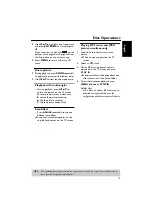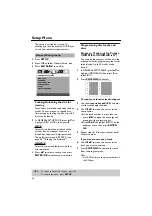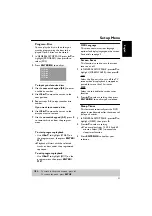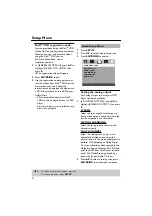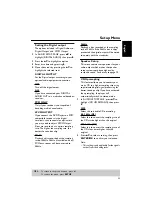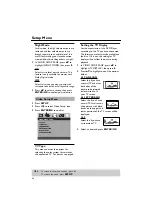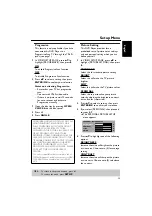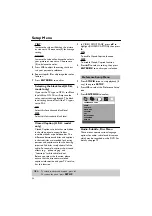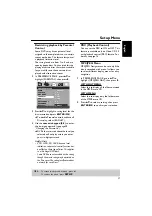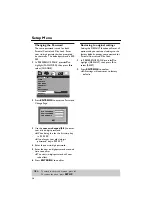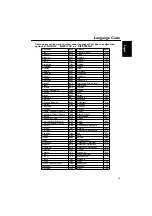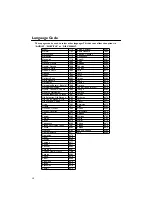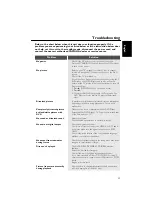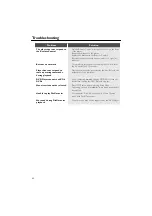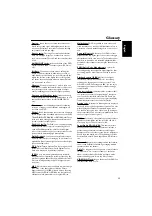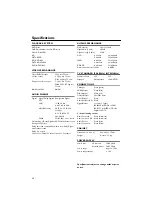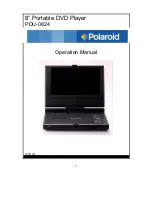
33
English
Glossary
Analog:
Sound that has not been turned into num-
bers. Analog sound varies, while digital sound has spe-
cific numerical values. These jacks send audio through
two channels, the left and right.
Aspect ratio:
The ratio of vertical and horizontal
sizes of a displayed image. The horizontal vs. vertical
ratio of conventional TVs. is 4:3, and that of widescreens
is 16:9.
AUDIO OUT Jacks:
Jacks on the back of the DVD
System that send audio to another system (TV, Stereo,
etc.).
Bit Rate:
The amount of data used to hold a given
length of music; measured in kilobits per seconds, or
kbps. Or, the speed at which you record. Generally, the
higher the bit rate, or the higher the recording speed,
the better the sound quality. However, higher bit rates
use more space on a Disc.
Chapter:
Sections of a picture or a music piece on a
DVD that are smaller than titles. A title is composed of
several chapters. Each chapter is assigned a chapter
number enabling you to locate the chapter you want.
Component Video Out Jacks:
Jacks on the back
of the DVD System that send high-quality video to a TV
that has Component Video In jacks (R/G/B, Y/Pb/Pr,
etc.).
Disc menu:
A screen display prepared for allowing
selection of images, sounds, subtitles, multi-angles, etc.
recorded on a DVD.
Digital:
Sound that has been converted into numerical
values. Digital sound is available when you use the DIGI-
TAL AUDIO OUT COAXIAL or OPTICAL jacks. These
jacks send audio through multiple channels, instead of
just two channels as analog does.
DivX 3.11/4x/5x:
The DivX code is a patent pending,
MPEG-4 based video compression technology, devel-
oped by DivXNetworks, Inc., that can shrink digital
video to sizes small enough to be transported over the
internet, while maintaining high visual quality.
Dolby Digital:
A surround sound system developed
by Dolby Laboratories containing up to six channels of
digital audio (front left and right, surround left and right,
center and subwoofer).
DTS:
Digital Theatre Systems. This is a surround sound
system, but it is different from Dolby Digital. The for-
mats were developed by different companies.
JPEG:
A very common digital still picture format. A
still-picture data compression system proposed by the
Joint Photographic Expert Group, which features small
decrease in image quality in spite of its high compres-
sion ratio.
MP3:
A file format with a sound data compression sys-
tem. “MP3” is the abbreviation of Motion Picture
Experts Group 1 (or MPEG-1) Audio Layer 3. By using
MP3 format, one CD-R or CD-RW can contain about
10 times as much data volume as a regular CD can.
Multichannel
DVD is specified to have each sound
track constitute one sound field. Multichannel refers to
a structure of sound tracks having three or more chan-
nels.
Parental Control:
A function of the DVD to limit
playback of the disc by the age of the users according to
the limitation level in each country. The limitation varies
from disc to disc; when it is activated, playback will be
prohibited if the software’s level is higher than the user-
set level.
PCM (Pulse Code Modulation):
A system for
converting analog sound signal to digital signal for later
processing, with no data compression used in conver-
sion.
Playback control (PBC):
Refers to the signal
recorded on video CDs or SVCDs for controlling
reproduction. By using menu screens recorded on a
Video CD or SVCD that supports PBC, you can enjoy
interactive-type software as well as software having a
search function.
Progressive Scan:
It displays all the horizontal lines
of a picture at one time, as a signal frame. This system
can convert the interlaced video from DVD into pro-
gressive format for connection to a progressive display.
It dramatically increases the vertical resolution.
Region code:
A system for allowing discs to be played
back only in the region designated beforehand. This unit
will only play discs that have compatible region codes.
You can find the region code of your unit by looking on
the product label. Some discs are compatible with more
than one region (or ALL regions).
S-Video:
Produces a clear picture by sending separate
signals for the luminance and the color. You can use S-
Video only if your TV has S- video In jack.
Super Audio CD (SA-CD):
This audio format is
based upon the current CD standards but includes a
greater amount of information that provides higher
quality sound. There are three types of discs: single layer,
double layer and hybrid discs. The hybrid disc contains
both standard audio CD and Super Audio CD informa-
tion.
Surround:
A system for creating realistic three dimen-
sional sound fields full of realism by arranging multiple
speakers around the listener.
Title:
The longest section of a picture or music feature
on DVD, music, etc., in video software, or the entire
album in audio software. Each title is assigned a title
number enabling you to locate the title you want.
VIDEO OUT jack:
Jack on the back of the DVD Sys-
tem that sends video to a TV.

